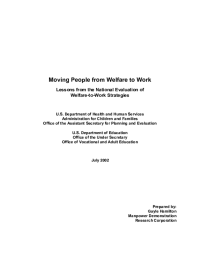Moving People from Welfare to Work
Lessons from the National Evaluation of Welfare-to-Work Strategies
Over the past three decades, federal and state policymakers have created a variety of programs with the common goal of moving people from welfare to work. How to go about increasing employment among welfare recipients, however, has long been debated. By laying out the lessons learned from the National Evaluation of Welfare-to-Work Strategies (NEWWS) — the most ambitious welfare employment study to date — this research synthesis provides answers to critical questions in the welfare-to-work policy discussion.
NEWWS examined the long-term effects on welfare recipients and their children of 11 mandatory welfare-to-work programs, operated in seven sites, that took different approaches to helping welfare recipients find jobs, advance in the labor market, and leave public assistance. A central question of the evaluation was: “What program strategies work best, and for whom?” Under study were two primary preemployment approaches — one that emphasized short-term job search assistance and encouraged people to find jobs quickly and one that emphasized longer-term skill-building activities (primarily basic education) before entering the labor market — and a third approach that mixed elements of the other two. The strategies’ success was measured with respect to the goals and combinations of goals that policymakers and program operators have set for welfare-to-work programs, which include cutting the welfare rolls, increasing employment, reducing poverty, not worsening (or, better still, improving) the well-being of children, and saving government money. The study examined the programs’ effects on single-parent welfare recipients, who account for the vast majority of the national welfare caseload, as well as on different subgroups thereof ― for example, those considered to be most disadvantaged with respect to their likelihood of finding steady employment. The evaluation also addressed important policy questions such as how to engage a substantial proportion of people in program activities and how enforcement of welfare-to-work participation mandates influences program effectiveness.
The effects of the NEWWS programs were estimated based on a wealth of data on more than 40,000 single-parent families, making NEWWS the largest study of welfare-to-work programs ever conducted. Parents and their children were tracked over a five-year follow-up period, which, depending on the site, spanned different parts of the 1990s. In the study’s innovative and rigorous research design, each parent was randomly assigned to a program group (in some sites, there were two program groups), whose members were eligible for program services and subject to the mandate, or a control group, whose members were not.
Conceived and funded by the U.S. Department of Health and Human Services, NEWWS received additional support from the U.S. Department of Education. The study was conducted by MDRC. Child Trends, as a subcontractor, conducted the Child Outcomes Study, the part of the evaluation that examined effects on young children. This research synthesis is the final publication from the evaluation.






